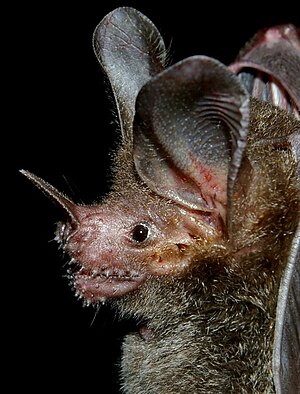Fringed Lipped Bat
| Fringed Lipped Bat | ||||||||||||
|---|---|---|---|---|---|---|---|---|---|---|---|---|

Fringed-lipped bat ( Trachops cirrhosus ) |
||||||||||||
| Systematics | ||||||||||||
|
||||||||||||
| Scientific name of the genus | ||||||||||||
| Trachops | ||||||||||||
| JE Gray , 1847 | ||||||||||||
| Scientific name of the species | ||||||||||||
| Trachops cirrhosus | ||||||||||||
| ( Spix , 1823) |
The fringed- lipped bat ( Trachops cirrhosus ) is a bat species from the subfamily of the lance-noses (Phyllostominae). It gets its name from the wart-like projections on the lower lip.
The fur of this bat is reddish-brown or greyish in color, characteristic are, as with many lance noses, the long, cross-furrowed ears and the pointed nosepiece. The animals reach a head trunk length of 76 to 88 millimeters and a weight of around 32 grams. The short tail becomes 12 to 21 millimeters long.
Fringed-lip bats are common from southern Mexico to Bolivia and southern Brazil . Their habitat is predominantly forests, sometimes they are also found on plantations. Tree hollows, caves or buildings serve as sleeping quarters.
The diet of these animals consists of insects and small vertebrates. Especially her hunt for frogs made them known. Frogs often croak in groups at night in order to attract females, the fringed-lip bats orient themselves to these noises and can kill up to 12 animals per hour. If the frogs remain silent, the yield of the bats is far lower. The fringed-lipped bats are also able to identify individual frog species based on their croaking noises, so they can differentiate between poisonous and edible prey.
literature
- Ronald M. Nowak: Walker's Mammals of the World . Johns Hopkins University Press, 1999 ISBN 0-8018-5789-9
Web links
- Illustrations
- Trachops cirrhosus inthe IUCN 2013 Red List of Threatened Species . Posted by: Miller, B., Reid, F., Arroyo-Cabrales, J., Cuarón, AD & de Grammont, PC, 2008. Retrieved December 28, 2013.